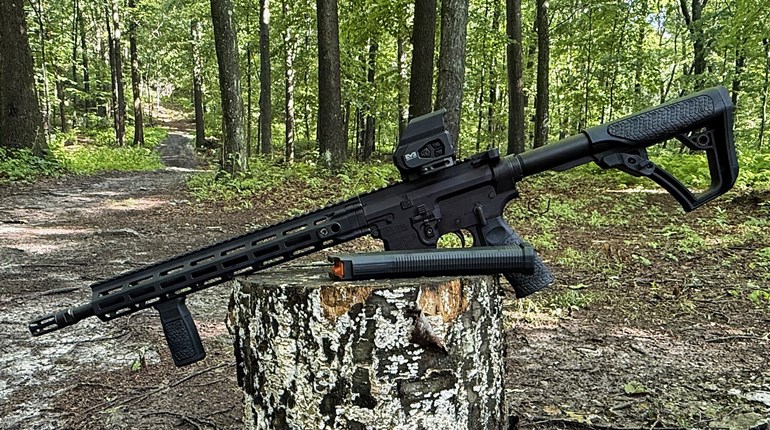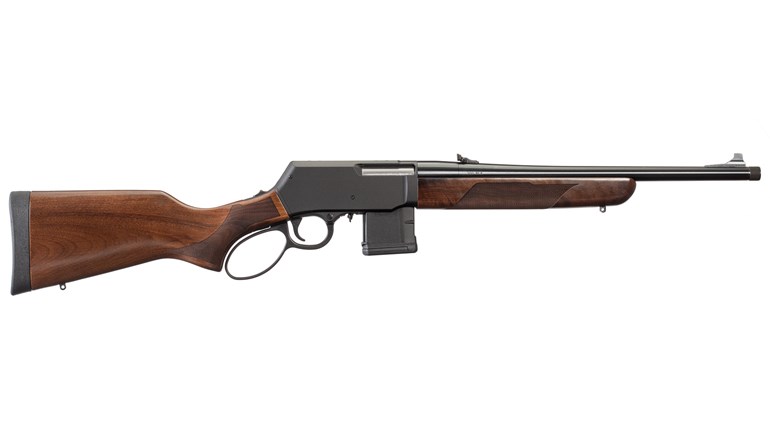
Over the past five years, there has been a surge of companies bringing their own Pistol Caliber Carbines to market. But, innovation has been mostly limited to weight reduction, ergonomics and different recoil systems, all focused on the widely adopted AR-15 design. That is, until JP Rifles announced the JP-5, a 9 mm PCC based on the roller-delayed blowback system.

My introduction to the world of Pistol Caliber Carbines was at the 2016 Steel Challenge World Speed Shooting Championships. After shooting a JP Rifles GMR-13 at a side match, I understood quickly what all the excitement was about.
To begin, first let’s look at the history of the roller-delayed blowback system and why it is important to the world of PCCs.
The roller-delayed blowback system was originally discovered by Mauser engineers during World War II in Germany. The most famous example is the Heckler & Koch MP5 submachine gun chambered in 9x19 mm Parabellum, developed in the 1960s—one of the most widely-used submachine guns around the world. While discussing the MP5 design, JP Marketing Director Jesse Gangl shared:
“For gun buffs and law enforcement, the H&K MP5 and its roller-delayed operating system is a landmark of firearm design. Both in terms of reliability and felt recoil, it's a marvel of a system that some JP guys have enjoyed for decades now. While it definitely adds more components and complexity to the operating system compared to a direct blowback, the advantages for the shooter are very noticeable. And thanks to H&K, it's a proven concept.”
The traditional blowback system is widely used because it is simplistic in design, with recoil tuning the average gun owner can do with basic tools, such as the Silent Capture System (SCS) from JP. The felt recoil is managed by adding or taking away weight with steel and tungsten weights. In addition, there are various springs used to give the feel the shooter desires.
The JP-5's main platform is completely different from a traditional AR-15, although the two platforms share peripheral items such as grip, stock, handguard and fire controls. The barrels, recoil system, upper receiver and bolts are not interchangeable.
After receiving my Steel-Challenge configured JP-5, I sat down with Jesse from JP to discuss the roller-delayed system and how it works. Jesse shared with me:
“The bolt of the JP-5 uses two rollers that engage with the trunnion and resist the bolt opening. These rollers bear on the locking piece. These locking pieces are available in multiple angles, which affects how the rollers interact with it, and hence, how much resistance there is to the bolt opening. Higher angles require less pressure to open the bolt, while lower angles require more. This allows the operating system to be tuned and optimized to run best with specific combinations of barrel lengths, ammunition, suppressors, etc.”
Each of the new JP-5s will be sent out with an "all-purpose" locking piece, and alternate angles will be available for shooters to optimize for different loads.
After receiving my JP-5, I broke down the bolt, which took three seconds, to separate the locking piece. My gun came with a marked "90" locking piece. I have run a couple thousand rounds, 115 power factor loads, and I am happy to report it has run flawlessly. Recoil impulse is short and soft, and the dot remains on target.

At the 2021 World Speed Shooting Championships in Talladega, Ala., I spent time with JP’s Dustin Sanchez with the first JP-5 and tested this innovative gun. I ran a PCC Steel Challenge load from PRN Ammunition, which is a 135-grain bullet traveling approximately 850 f.p.s., out of my ultra-lightweight barrel in my GMR-15. After trying a couple of locking devices, the "70" optimized the platform for this load. People overuse the statement “my gun shoots like a .22.” Well, this JP-5 shot smoother than a .22. Note that we did not change out the SCS of the rifle, but I am unsure how further improvement could be made over the felt recoil. Double taps on targets were routine, with negligible dot movement at 15 yards.
The first production run sold out like a New Kids on the Block reunion tour. These rifles will be delivered in the fourth quarter of 2021. JP is currently offering the JP-5 in three configurations for pre-order for delivery in late second quarter of 2022.
The configurations for pre-order are: JP-5 All-Purpose Carbine (MSRP $3,199), JP-5 Competition PCC (MSRP $3,269), and the JP-5 Steel Challenge Carbine (MSRP $3,349). All configurations are outfitted with the same machined billet JP-5 940 receiver set, 14.5-inch Supermatch light contoured 1:10-inch twist barrel, Radian Raptor top-charge handle, 3.5- to 4.0-pound trigger, Hogue grip and a 9 mm JP-5 Silent Capture spring.
The main differences in the three models are barrel finishes, compensators, handguards and stocks. The All-Purpose Carbine features a black Teflon barrel finish with a tactical compensator, MK III Rapid Configuration 12.5-inch handguard and Hogue Overmolded stock. The JP-5 Competition PCC has a polished steel barrel with competition compensator, MKIII Rapid Configuration 12.5-inch handguard and Hogue Overmolded stock. Finally, the JP-5 Steel Challenge Carbine has a titanium pin and welded compensator, M-Lok series 12.5-inch handguard with a Mission First tactical stock.

As for the Steel Challenge setup, the overall weight drops from six pounds to just over five-and-a-half pounds. For those interested in a full custom build, JP will be offering them next year.
In the Steel Challenge community, we are greatly anticipating the release of the ultra-lightweight barrel. The 5.5-inch shrouded barrel should get the JP-5 just under the five-pound barrier, resulting in one of the lightest PCCs on the market. The weight of the 14.5-inch barrel with a pinned and welded titanium compensator feels uncompromised while transitioning the gun from target to target at speed. The M-Lok handguard shaves a couple of ounces off the MKIII handguard to mitigate left-over weight of the light contour barrel. One of the surprises of the JP-5 are the built-in ambidextrous controls with a bolt release on the right-hand side of the gun. From a shooter’s perspective, you can tell there is weight removed from both the bolt, as well as the recoil system, allowing the gun to feel faster in operation compared to my GMR-15. The gun is always ready for me to pull the trigger. In addition, the height over bore of the JP-5 offers the familiarity we have with the AR-15-style GMR-15.
If you are interested in ordering your own JP-5 or any other JP products, visit JPRifles.com.
Article from the September/October 2021 issue of USPSA’s magazine.
Read more: How To Clear 4 Common Semi-Automatic Malfunctions


































